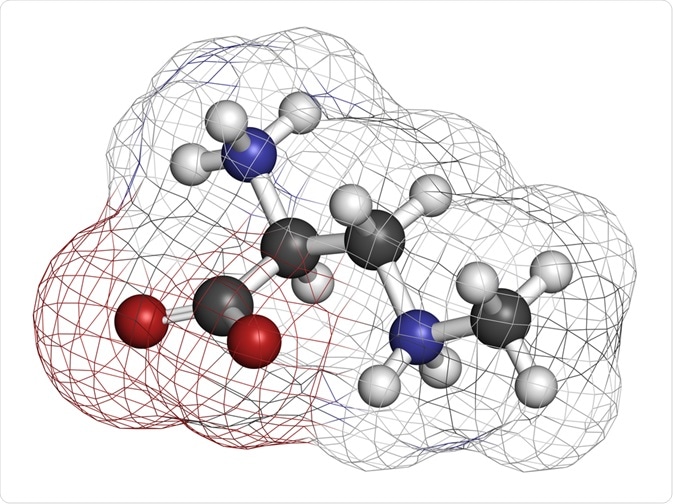Alongside the classical 20 protein amino acids, which are used to build proteins, there are more than 1000 non-protein amino acids in nature. Occasional mistakes can mean these non-protein amino acids are incorporated into proteins during translation, which can result in misfolding and other detrimental effects.
 Image Credits: StudioMolekuul / Shutterstock.com
Image Credits: StudioMolekuul / Shutterstock.com
Non-protein amino acids
While more commonly known than non-protein amino acids, protein amino acids make up only around 2% of all amino acids known to exist. Non-protein amino acids are highly abundant in plants, but others can be produced from amino acid oxidation in the body or are produced synthetically.
Some commonly consumed sources of non-protein amino acids include alfalfa and lentils, but others are also inadvertently harvested with crop species. For example, the non-protein amino acid BMAA has been linked to shellfish consumption and proximity to lakes with cyanobacterial algal blooms.
When non-protein amino acids have structures that closely resemble protein amino acids, they can be mistakenly incorporated into proteins during translation. However, for this to happen, the non-protein amino acid has to be present at high enough concentrations in the cell to successfully compete with protein amino acids.
How non-protein amino acids affect proteins
The effect of misincorporation of non-protein amino acids can result in defective structure and function. One common effect is aggregation and tangling of proteins. The type of proteins targeted by misincorporation can affect the severity of the damage.
One example of this is motor neurons. Motor neurons are particularly vulnerable to protein aggregation because they cannot get rid of terminally aggregated proteins by distributing them to daughter cells. Motor neurons are also susceptible because of their length, which means any aggregation can fatally damage transport along the axon.
Apart from aggregation, misincorporation of non-protein amino acids into proteins can lead to misfolding, losing aqueous solubility, and production of autofluorescent material in situ. There are also non-protein amino acids that are not dangerous to humans.
Diseases associated with non-protein amino acids
Two non-protein amino acids that are commonly misincorporated into proteins are canavine and L-dopa (3,4 dihydroxyphenylalanine). Canavanine is lethal to rats when in high concentration, as it originates from a species of bean where it uses the amino acid to kill the larvae of predators.
Another important non-protein amino acid is BMAA (β-N-methylamino-L-alanine). It is found in cyanobacteria and other microorganisms, but there is evidence that BMAA can be misincorporated in mammal proteins. In humans, it is misincorporated into proteins in the place of L-serine, but L-serine can also inhibit BMAA’s misincorporation.
The misincorporation of BMAA is shown to occur in neuroproteins and results in abnormalities, such as Bunina bodies, Lewy body inclusions, senile plaques, and neurofibrillary tangles. BMAA misincorporation has also been shown to cause apoptosis in neuroblastoma cells when in vitro. The effect of the misincorporation of BMAA is associated with neurodegenerative diseases like ALS.
Misfolded brain cell proteins like α-synuclein can cause a neurodegenerative cascade of misfolded proteins, and it is hypothesized that a similar cascade could occur due to misfolded proteins from non-protein amino acid misincorporation.
From legumes, a dangerous non-protein amino acid is homoarginine. While its effects have been disputed, evidence suggests this non-protein amino acid also affects the brain. In mice, homoarginine stopped the uptake of lysine and arginine by the brain. These effects have not been found in humans, but it is an uncompetitive inhibitor of human liver and bone alkaline phosphatases.
There are also some less deadly non-protein amino acids. For example, the mushroom Coprinus atramentarius contains coprine (N5-(1-hydroxycyclopropyl)-L-glutamine), which inhibits alcohol dehydrogenase and causes severely unpleasant, but not fatal, effects. More seriously, the non-protein amino acid hypoglycin has been tentatively linked with birth defects as it competed with its structural analog leucine, which is essential for normal development.
Sources
- Rodgers, K.J. (2014). Non-protein amino acids and neurodegeneration: the enemy within. Experimental Neurology. https://doi.org/10.1016/j.expneurol.2013.12.010
- Dunlop, R.A. et al. (2013). The non-protein amino acid BMAA is misincorporated into human proteins in place of l-serine causing protein misfolding and aggregation. PLoS One. https://doi.org/10.1371/journal.pone.0075376
- Nunn, P.B. et al. (2010). Toxicity of non-protein amino acids to humans and domestic animals. Natural Product Communications. https://doi.org/10.1177/1934578X1000500329
Further Reading
Last Updated: Jun 2, 2020